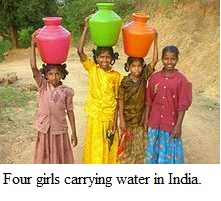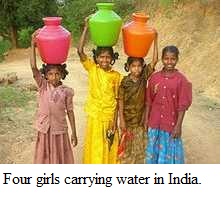Chapter: Civil : Environmental Engineering
Water supply and sanitation in India -Part 1

Water supply and sanitation in India -Part
1
continue to be inadequate, despite longstanding efforts by the various levels of government and communities at improving coverage. The level of investment in water and sanitation, albeit low by international standards, has increased during the 2000s. Access has also increased significantly. For example, in 1980 rural sanitation coverage was estimated at 1% and reached 21% in 2008. Also, the share of Indians with access to improved sources of water has increased significantly from 72% in 1990 to 88% in 2008. At the same time, local government institutions in charge of operating and maintaining the infrastructure are seen as weak and lack the financial resources to carry out their functions. In addition, no major city in India is known to have a continuous water supply and an estimated 72% of Indians still lack access to improved sanitation facilities.
A number of innovative
approaches to improve water supply and sanitation have been tested in India, in
particular in the early 2000s. These include demand-driven approaches in rural
water supply since 1999, community-led total sanitation, a public-private
partnerships to improve the continuity of urban water supply in Karnataka, and
the use of micro-credit to women in order to improve access to water
In 2008, 88% of the
population in India had access to an improved water source, but only 31% had
access to improved sanitation. In rural areas, where 72% of India's population
lives,
the respective shares
are 84% for water and only 21% for sanitation. In urban areas, 96% had access
to an improved water source and 54% to improved sanitation. Access has improved
substantially since 1990 when it was estimated to stand at 72% for water and
18% for sanitation.
According to
Indian norms, access
to improved water
supply exists ifat least 40 liters/capita/day of safe drinking
water are provided
within a distance of 1.6 km
or 100 meter of elevation difference, to be relaxed as per field
conditions. There should be at least one pump per 250 persons.
Service quality
Water
and sanitation service quality in India is generally poor, although there has
been some limited progress concerning continuity of supply in urban areas and
access to sanitation in rural areas.
Water
supply

Challenges.
None of the 35 Indian cities with a population of more than one million
distribute water for more than a few hours per day, despite generally
sufficient infrastructure. Owing to inadequate pressure people struggle to
collect water even when it is available. According to the World Bank, none have
performance indicators that compare with average international standards. A
2007 study by the Asian Development Bank showed that in 20 cities the average
duration of supply was only 4.3 hours per day. No city had continuous supply.
The longest duration of supply was 12 hours per day in Chandigarh, and the
lowest was 0.3 hours per day in Rajkot. In Delhi residents receive water only a
few hours per day because of inadequate management of the distribution system.
This results in contaminated water and forces households to complement a
deficient public water service at prohibitive 'coping' costs; the poor suffer
most from this situation. For example, according to a 1996 survey households in
Delhi spent an average of 2,182 (US$48.4) per year in time and money to cope
with poor service levels. This is more than three times as much as the 2001
water bill of about US$18 per year of a Delhi household that uses 20 cubic
meters per month.
Achievements.
Jamshedpur, a city in Jharkhand with 573,000 inhabitants, provided 25% of its
residents with continuous water supply in 2009. Navi Mumbai, a planned city
with more than 1m inhabitants, has achieved continuous supply for about half
its population as of January 2009. Badlapur, another city in the Mumbai
Conurbation with a population of 140,000, has achieved continuous supply in 3
out of 10 operating zones, covering 30% of its population. Thiruvananthapuram,
the capital of Kerala state with a population of 745,000 in 2001, is probably
the largest Indian city that enjoys continuous water supply.
Sanitation
Most
Indians depend on on-site sanitation facilities. Recently, access to on-site
sanitation have increased in both rural and urban areas. In rural areas, total
sanitation has been successful (see below). In urban areas, a good practice is
the Slum Sanitation Program in Mumbai that has provided access to sanitation
for a quarter million slum dwellers. Sewerage, where available, is often in a
bad state. In Delhi the sewerage network has lacked maintenance over the years
and overflow of raw sewage in open drains is common, due to blockage,
settlements and inadequate pumping capacities. The capacity of the 17 existing
wastewater treatment plants in Delhi is adequate to cater a daily production of
waste water of less than 50% of the drinking water produced. Of the 2.5 Billion
people in the world that defecate openly, some
665
million live in India. This is of greater concern as 88% of deaths from
diarrhea occur because of unsafe water, inadequate sanitation and poor hygiene.
Environment
As of 2003, it was
estimated that only 27% of India's wastewater was being treated, with the
remainder flowing into rivers, canals, groundwater or the sea., For example,
the sacred
Ganges river is
infested with diseases and in some places "the Ganges becomes black and
septic. Corpses, of semi-cremated adults or enshrouded babies, drift slowly
by.". NewsWeek describes Delhi's sacred Yamuna River as "a putrid
ribbon of black sludge" where fecal bacteria is 10,000 over safety limits
despite a 15-year program to address the problem. Cholera epidemics are not
unknown.
Health impact
The lack of adequate
sanitation and safe water has significant negative health impacts including
diarrhea, referred to by travelers as the "Delhi Belly", and
experienced by about 10 million visitors annually. While most visitors to India
recover quickly and otherwise receive proper care, the World Health
Organisation estimated that around 700,000 Indians die each year from diarrhea.
The dismal working conditions of sewer workers are another concern. A survey of
the working conditions of sewage workers in Delhi showed that most of
them suffer from
chronic diseases, respiratory problems, skin disorders, allergies, headaches
and eye infections.
Related Topics